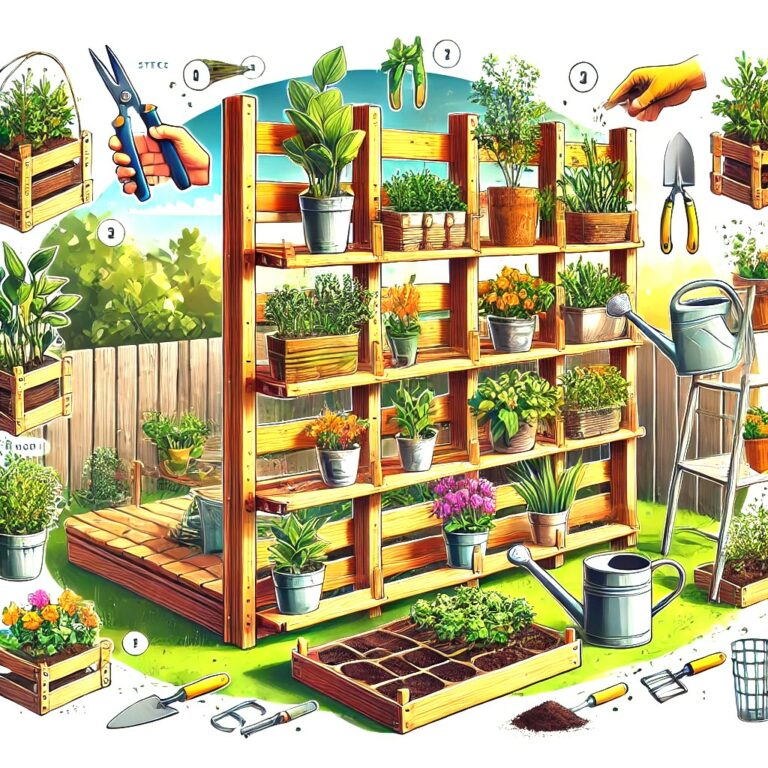Introduction
Vertical gardens are a great way to maximize space, especially in urban settings with limited ground space. These innovative gardens allow you to grow various plants upwards, creating a stunning visual impact and efficient use of space. This guide will help you understand how to build a vertical garden, from selecting the right plants to construction and maintenance tips.
Benefits of Vertical Gardens
Vertical gardens offer numerous advantages beyond just saving space. They can improve air quality, decrease energy costs, and create a unique aesthetic appeal.
Space Efficiency
Growing plants vertically allows you to utilize unused wall space, balconies, and fences. It is particularly favourable for urban dwellers with limited yard space.
Improved Air Quality
Plants in vertical gardens can help filter pollutants and adjust the overall air quality in your living space.
Insulation and Energy Savings
Vertical gardens can provide natural insulation for buildings, lowering heating and cooling costs by creating a buffer against temperature fluctuations.
Choosing the Right Location
Selecting the appropriate location for your vertical garden is crucial. Consider areas that receive adequate sunlight and are easily accessible for maintenance.
Indoor vs. Outdoor
Decide whether you want your vertical garden indoors or outdoors. Indoor vertical gardens enhance your interior décor, while outdoor gardens beautify your exterior spaces.
Designing Your Vertical Garden
There are various ways to design a vertical garden, from simple DIY projects to professional installations. Choose a design that suits your space and budget.
Types of Vertical Gardens
- Living Walls: These are large-scale vertical gardens that cover entire walls with various plants.
- Trellis Systems: Ideal for climbing plants like beans and peas, these structures support plant growth vertically.
- Pocket Gardens: Fabric pockets attached to a frame, suitable for smaller plants and herbs.
Selecting Plants for Vertical Gardens
Choosing the right plants is vital for a practical vertical garden. Think about plants that thrive in your climate and fit the specific conditions of your desired location.
Best Plants for Vertical Gardens
- Herbs: Basil, thyme, and oregano are perfect for vertical gardens and easy to maintain.
- Flowers: Petunias, begonias, and fuchsias add colour and attract pollinators.
- Vegetables: Lettuce, spinach, and cherry tomatoes can be grown vertically, providing fresh produce.
Building Your Vertical Garden
Creating a vertical garden can be a DIY project or involve professional help, depending on the complexity and scale of your design.
DIY Vertical Garden Ideas
- Pallet Garden: Recycle old pallets by attaching fabric or plastic to create plant pockets.
- Gutter Garden: Use old rain gutters mounted on a wall to grow small plants and herbs.
- Frame and Pockets: Attach fabric pockets to a wooden frame for a versatile, portable vertical garden.
Installing Irrigation Systems
An efficient irrigation system is vital for the health of your vertical garden. Drip irrigation and self-watering systems are excellent choices.
Drip Irrigation
This system delivers water directly to the roots of each plant, minimizing water waste and ensuring even moisture distribution.
Self-Watering Systems
These systems use reservoirs to provide consistent moisture to plants, reducing manual watering frequency.
Maintenance Tips
Maintaining a vertical garden requires regular care, including watering, fertilizing, and pruning.
Regular Watering
Ensure your vertical garden receives adequate water. Check the moisture levels regularly, especially during hot weather.
Fertilizing
Use organic fertilizers to provide basic nutrients to your plants. Follow a feeding schedule based on the plants’ specific needs in your garden.
Pruning and Harvesting
Regularly pruning plants motivate healthy growth and prevent overcrowding. Harvest herbs and vegetables as needed to promote continued production.
Conclusion
Building a vertical garden is an innovative way to increase space, improve air quality, and enhance the beauty of your home. You can create a unique vertical garden that brings nature closer to you by choosing the right location, plants, and design. Start your vertical garden project today and enjoy the numerous benefits it offers.
- Growing Bonsai: Tips for Miniature Tree Enthusiasts
- Buying Bonsai: Tips for Selecting Your Perfect Tree
- Bonsai Potting: Essential Tips for Tree Care Success
- Bonsai Maintenance: Essential Care for Tiny Trees
- Mastering the Art of Shaping Bonsai: A Beginner’s Guide
Source: A Complete Guide to Vertical Gardening


